NUR222 Assignment: Ethical and Legal Dilemmas in Nursing Care
VerifiedAdded on 2023/01/04
|12
|3914
|2
Report
AI Summary
This report analyzes two nursing case studies, addressing ethical and legal dilemmas encountered in clinical practice. The first case examines a student nurse's dilemma regarding patient consent in the operating theatre, discussing patient autonomy, informed consent, and the role of the Nursing and Midwifery Board of Australia's code of conduct. The second case focuses on a registered nurse's concern about a colleague's breach of hand hygiene protocols, emphasizing infection control measures and relevant legislation. Each case includes discussions on legislation, reflective practice, and ethical decision-making, highlighting the importance of upholding patient rights, maintaining professional standards, and ensuring patient safety within the healthcare environment. The report emphasizes the application of ethical principles, legal frameworks, and reflective practice in nursing to improve patient outcomes. This document is a past paper uploaded by a student and is available on Desklib, a platform providing AI-based study tools for students.
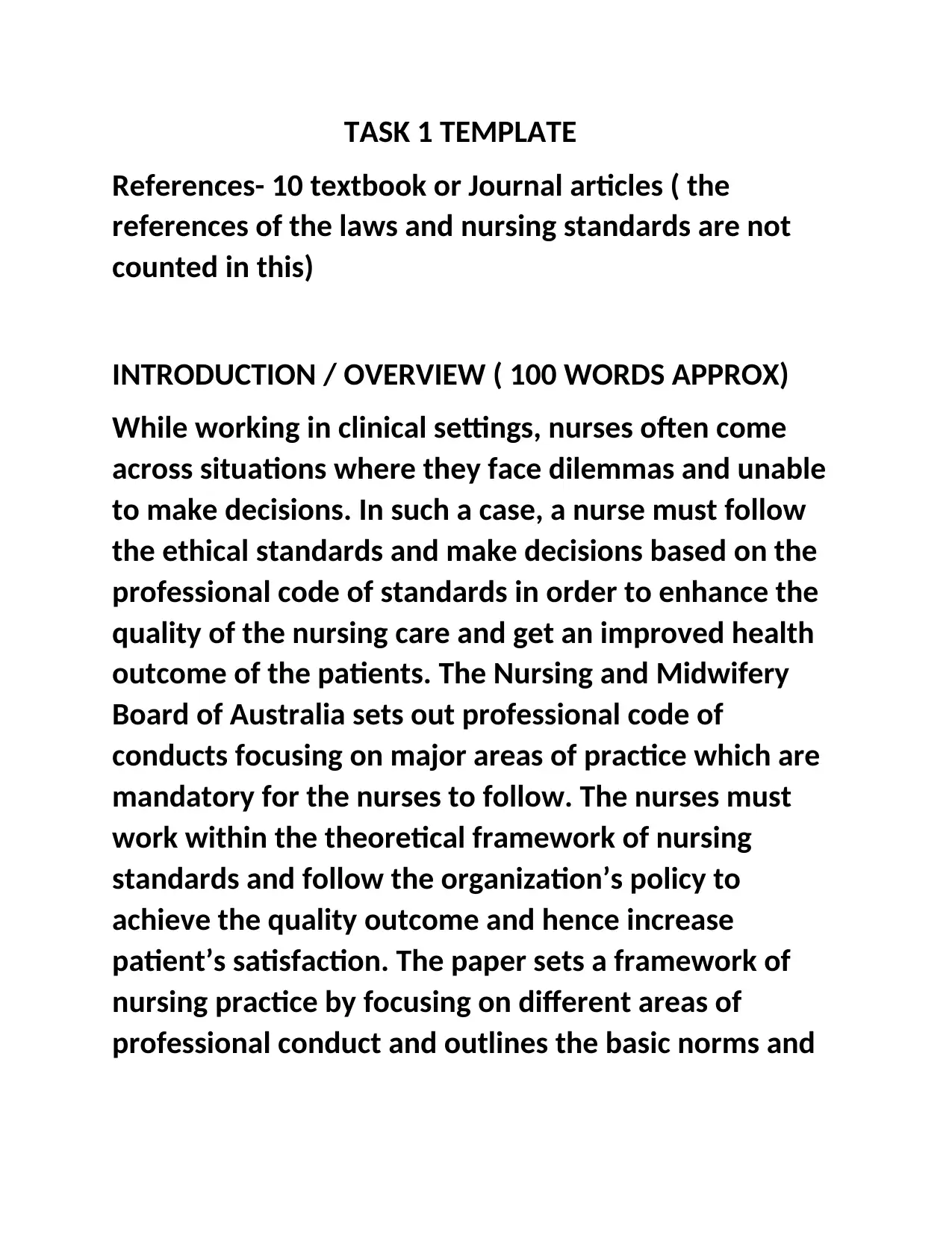
TASK 1 TEMPLATE
References- 10 textbook or Journal articles ( the
references of the laws and nursing standards are not
counted in this)
INTRODUCTION / OVERVIEW ( 100 WORDS APPROX)
While working in clinical settings, nurses often come
across situations where they face dilemmas and unable
to make decisions. In such a case, a nurse must follow
the ethical standards and make decisions based on the
professional code of standards in order to enhance the
quality of the nursing care and get an improved health
outcome of the patients. The Nursing and Midwifery
Board of Australia sets out professional code of
conducts focusing on major areas of practice which are
mandatory for the nurses to follow. The nurses must
work within the theoretical framework of nursing
standards and follow the organization’s policy to
achieve the quality outcome and hence increase
patient’s satisfaction. The paper sets a framework of
nursing practice by focusing on different areas of
professional conduct and outlines the basic norms and
References- 10 textbook or Journal articles ( the
references of the laws and nursing standards are not
counted in this)
INTRODUCTION / OVERVIEW ( 100 WORDS APPROX)
While working in clinical settings, nurses often come
across situations where they face dilemmas and unable
to make decisions. In such a case, a nurse must follow
the ethical standards and make decisions based on the
professional code of standards in order to enhance the
quality of the nursing care and get an improved health
outcome of the patients. The Nursing and Midwifery
Board of Australia sets out professional code of
conducts focusing on major areas of practice which are
mandatory for the nurses to follow. The nurses must
work within the theoretical framework of nursing
standards and follow the organization’s policy to
achieve the quality outcome and hence increase
patient’s satisfaction. The paper sets a framework of
nursing practice by focusing on different areas of
professional conduct and outlines the basic norms and
Paraphrase This Document
Need a fresh take? Get an instant paraphrase of this document with our AI Paraphraser
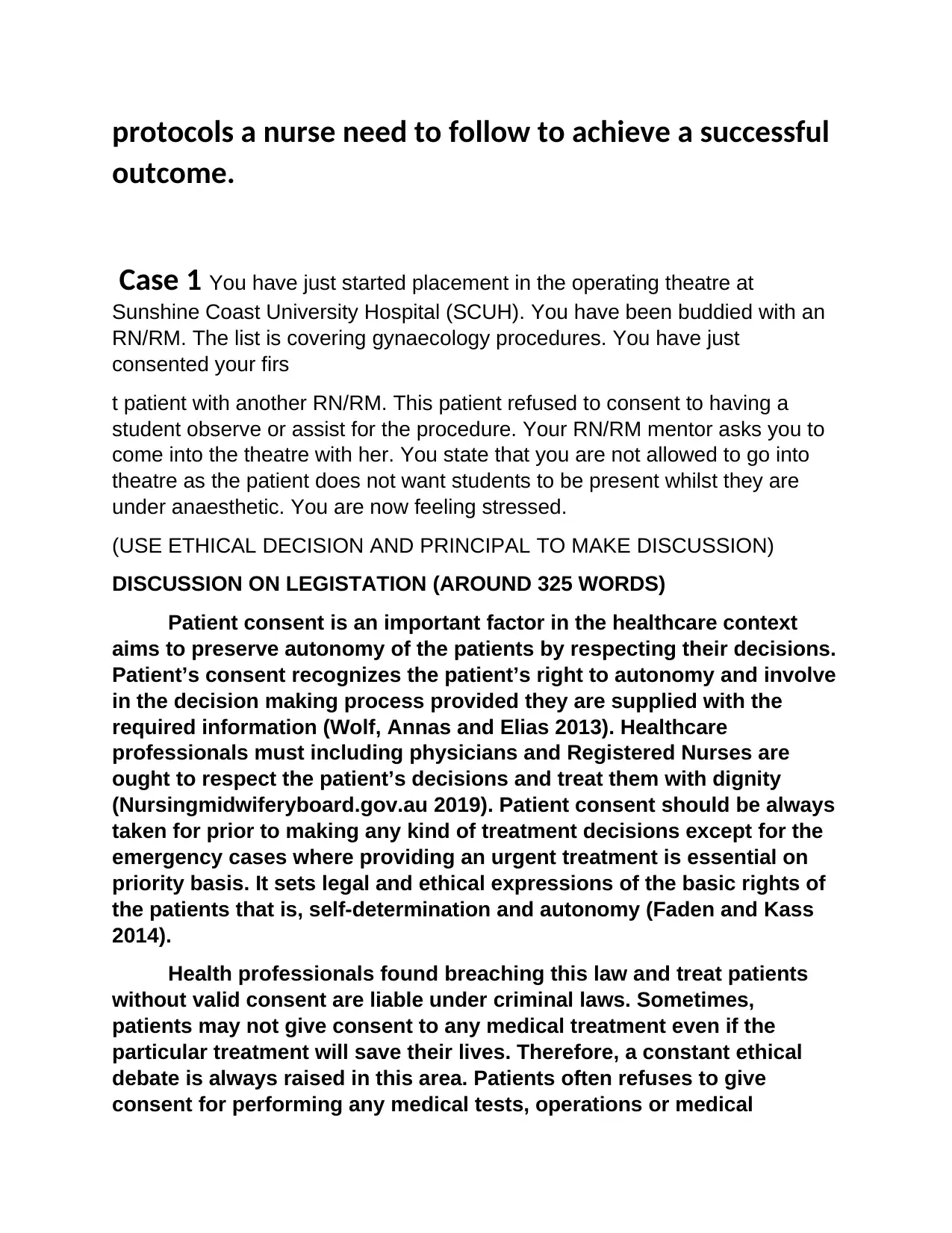
protocols a nurse need to follow to achieve a successful
outcome.
Case 1 You have just started placement in the operating theatre at
Sunshine Coast University Hospital (SCUH). You have been buddied with an
RN/RM. The list is covering gynaecology procedures. You have just
consented your firs
t patient with another RN/RM. This patient refused to consent to having a
student observe or assist for the procedure. Your RN/RM mentor asks you to
come into the theatre with her. You state that you are not allowed to go into
theatre as the patient does not want students to be present whilst they are
under anaesthetic. You are now feeling stressed.
(USE ETHICAL DECISION AND PRINCIPAL TO MAKE DISCUSSION)
DISCUSSION ON LEGISTATION (AROUND 325 WORDS)
Patient consent is an important factor in the healthcare context
aims to preserve autonomy of the patients by respecting their decisions.
Patient’s consent recognizes the patient’s right to autonomy and involve
in the decision making process provided they are supplied with the
required information (Wolf, Annas and Elias 2013). Healthcare
professionals must including physicians and Registered Nurses are
ought to respect the patient’s decisions and treat them with dignity
(Nursingmidwiferyboard.gov.au 2019). Patient consent should be always
taken for prior to making any kind of treatment decisions except for the
emergency cases where providing an urgent treatment is essential on
priority basis. It sets legal and ethical expressions of the basic rights of
the patients that is, self-determination and autonomy (Faden and Kass
2014).
Health professionals found breaching this law and treat patients
without valid consent are liable under criminal laws. Sometimes,
patients may not give consent to any medical treatment even if the
particular treatment will save their lives. Therefore, a constant ethical
debate is always raised in this area. Patients often refuses to give
consent for performing any medical tests, operations or medical
outcome.
Case 1 You have just started placement in the operating theatre at
Sunshine Coast University Hospital (SCUH). You have been buddied with an
RN/RM. The list is covering gynaecology procedures. You have just
consented your firs
t patient with another RN/RM. This patient refused to consent to having a
student observe or assist for the procedure. Your RN/RM mentor asks you to
come into the theatre with her. You state that you are not allowed to go into
theatre as the patient does not want students to be present whilst they are
under anaesthetic. You are now feeling stressed.
(USE ETHICAL DECISION AND PRINCIPAL TO MAKE DISCUSSION)
DISCUSSION ON LEGISTATION (AROUND 325 WORDS)
Patient consent is an important factor in the healthcare context
aims to preserve autonomy of the patients by respecting their decisions.
Patient’s consent recognizes the patient’s right to autonomy and involve
in the decision making process provided they are supplied with the
required information (Wolf, Annas and Elias 2013). Healthcare
professionals must including physicians and Registered Nurses are
ought to respect the patient’s decisions and treat them with dignity
(Nursingmidwiferyboard.gov.au 2019). Patient consent should be always
taken for prior to making any kind of treatment decisions except for the
emergency cases where providing an urgent treatment is essential on
priority basis. It sets legal and ethical expressions of the basic rights of
the patients that is, self-determination and autonomy (Faden and Kass
2014).
Health professionals found breaching this law and treat patients
without valid consent are liable under criminal laws. Sometimes,
patients may not give consent to any medical treatment even if the
particular treatment will save their lives. Therefore, a constant ethical
debate is always raised in this area. Patients often refuses to give
consent for performing any medical tests, operations or medical
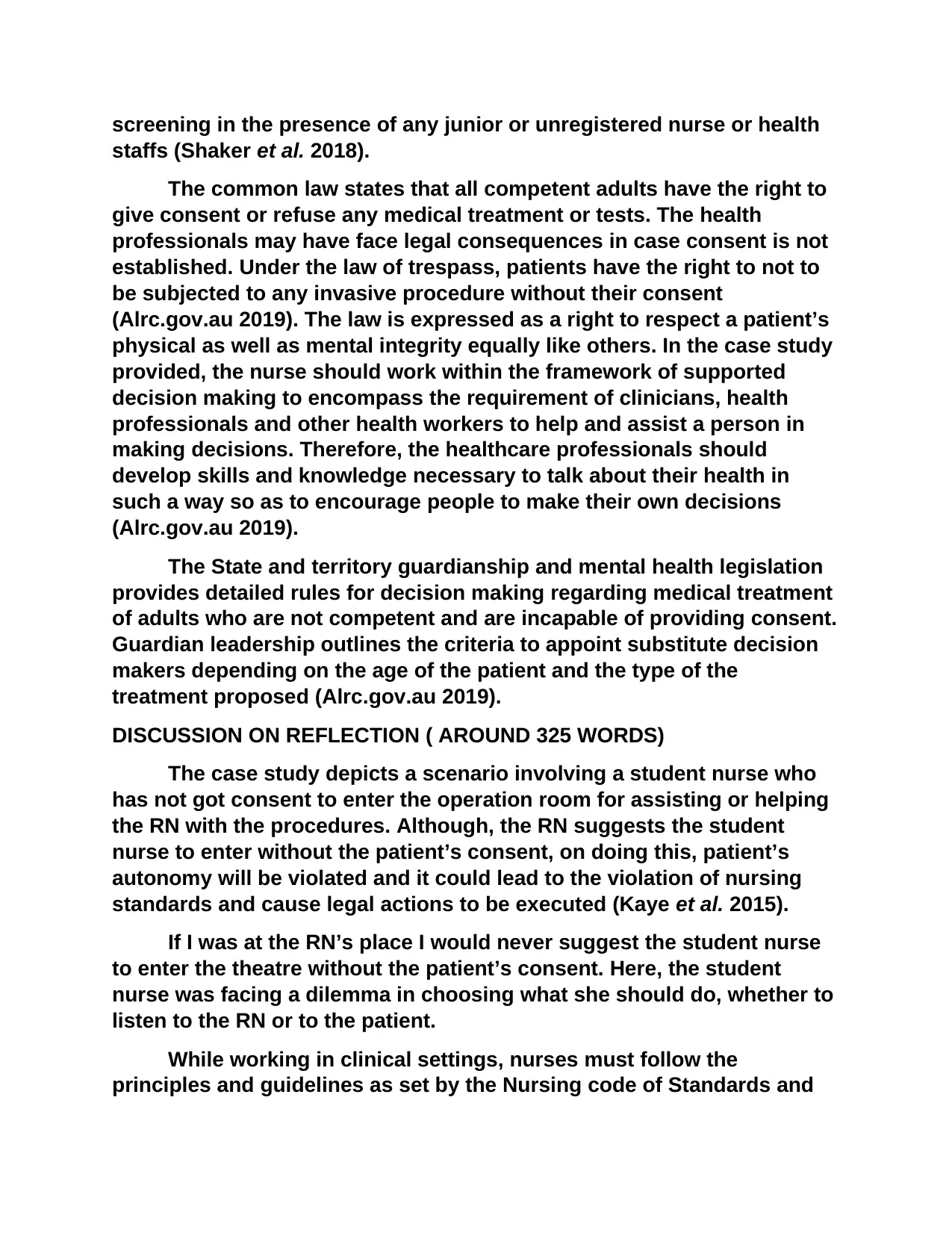
screening in the presence of any junior or unregistered nurse or health
staffs (Shaker et al. 2018).
The common law states that all competent adults have the right to
give consent or refuse any medical treatment or tests. The health
professionals may have face legal consequences in case consent is not
established. Under the law of trespass, patients have the right to not to
be subjected to any invasive procedure without their consent
(Alrc.gov.au 2019). The law is expressed as a right to respect a patient’s
physical as well as mental integrity equally like others. In the case study
provided, the nurse should work within the framework of supported
decision making to encompass the requirement of clinicians, health
professionals and other health workers to help and assist a person in
making decisions. Therefore, the healthcare professionals should
develop skills and knowledge necessary to talk about their health in
such a way so as to encourage people to make their own decisions
(Alrc.gov.au 2019).
The State and territory guardianship and mental health legislation
provides detailed rules for decision making regarding medical treatment
of adults who are not competent and are incapable of providing consent.
Guardian leadership outlines the criteria to appoint substitute decision
makers depending on the age of the patient and the type of the
treatment proposed (Alrc.gov.au 2019).
DISCUSSION ON REFLECTION ( AROUND 325 WORDS)
The case study depicts a scenario involving a student nurse who
has not got consent to enter the operation room for assisting or helping
the RN with the procedures. Although, the RN suggests the student
nurse to enter without the patient’s consent, on doing this, patient’s
autonomy will be violated and it could lead to the violation of nursing
standards and cause legal actions to be executed (Kaye et al. 2015).
If I was at the RN’s place I would never suggest the student nurse
to enter the theatre without the patient’s consent. Here, the student
nurse was facing a dilemma in choosing what she should do, whether to
listen to the RN or to the patient.
While working in clinical settings, nurses must follow the
principles and guidelines as set by the Nursing code of Standards and
staffs (Shaker et al. 2018).
The common law states that all competent adults have the right to
give consent or refuse any medical treatment or tests. The health
professionals may have face legal consequences in case consent is not
established. Under the law of trespass, patients have the right to not to
be subjected to any invasive procedure without their consent
(Alrc.gov.au 2019). The law is expressed as a right to respect a patient’s
physical as well as mental integrity equally like others. In the case study
provided, the nurse should work within the framework of supported
decision making to encompass the requirement of clinicians, health
professionals and other health workers to help and assist a person in
making decisions. Therefore, the healthcare professionals should
develop skills and knowledge necessary to talk about their health in
such a way so as to encourage people to make their own decisions
(Alrc.gov.au 2019).
The State and territory guardianship and mental health legislation
provides detailed rules for decision making regarding medical treatment
of adults who are not competent and are incapable of providing consent.
Guardian leadership outlines the criteria to appoint substitute decision
makers depending on the age of the patient and the type of the
treatment proposed (Alrc.gov.au 2019).
DISCUSSION ON REFLECTION ( AROUND 325 WORDS)
The case study depicts a scenario involving a student nurse who
has not got consent to enter the operation room for assisting or helping
the RN with the procedures. Although, the RN suggests the student
nurse to enter without the patient’s consent, on doing this, patient’s
autonomy will be violated and it could lead to the violation of nursing
standards and cause legal actions to be executed (Kaye et al. 2015).
If I was at the RN’s place I would never suggest the student nurse
to enter the theatre without the patient’s consent. Here, the student
nurse was facing a dilemma in choosing what she should do, whether to
listen to the RN or to the patient.
While working in clinical settings, nurses must follow the
principles and guidelines as set by the Nursing code of Standards and
⊘ This is a preview!⊘
Do you want full access?
Subscribe today to unlock all pages.

Trusted by 1+ million students worldwide
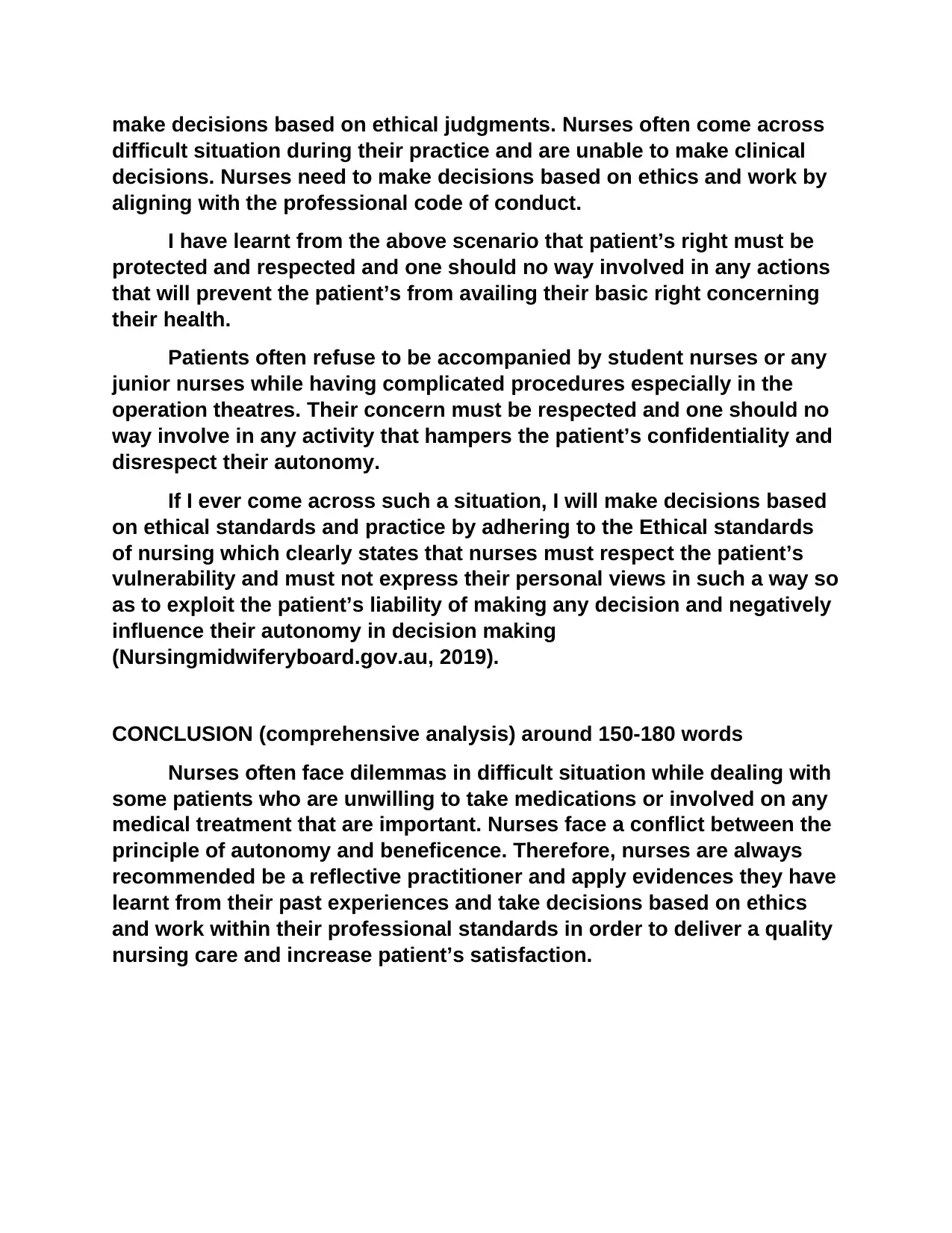
make decisions based on ethical judgments. Nurses often come across
difficult situation during their practice and are unable to make clinical
decisions. Nurses need to make decisions based on ethics and work by
aligning with the professional code of conduct.
I have learnt from the above scenario that patient’s right must be
protected and respected and one should no way involved in any actions
that will prevent the patient’s from availing their basic right concerning
their health.
Patients often refuse to be accompanied by student nurses or any
junior nurses while having complicated procedures especially in the
operation theatres. Their concern must be respected and one should no
way involve in any activity that hampers the patient’s confidentiality and
disrespect their autonomy.
If I ever come across such a situation, I will make decisions based
on ethical standards and practice by adhering to the Ethical standards
of nursing which clearly states that nurses must respect the patient’s
vulnerability and must not express their personal views in such a way so
as to exploit the patient’s liability of making any decision and negatively
influence their autonomy in decision making
(Nursingmidwiferyboard.gov.au, 2019).
CONCLUSION (comprehensive analysis) around 150-180 words
Nurses often face dilemmas in difficult situation while dealing with
some patients who are unwilling to take medications or involved on any
medical treatment that are important. Nurses face a conflict between the
principle of autonomy and beneficence. Therefore, nurses are always
recommended be a reflective practitioner and apply evidences they have
learnt from their past experiences and take decisions based on ethics
and work within their professional standards in order to deliver a quality
nursing care and increase patient’s satisfaction.
difficult situation during their practice and are unable to make clinical
decisions. Nurses need to make decisions based on ethics and work by
aligning with the professional code of conduct.
I have learnt from the above scenario that patient’s right must be
protected and respected and one should no way involved in any actions
that will prevent the patient’s from availing their basic right concerning
their health.
Patients often refuse to be accompanied by student nurses or any
junior nurses while having complicated procedures especially in the
operation theatres. Their concern must be respected and one should no
way involve in any activity that hampers the patient’s confidentiality and
disrespect their autonomy.
If I ever come across such a situation, I will make decisions based
on ethical standards and practice by adhering to the Ethical standards
of nursing which clearly states that nurses must respect the patient’s
vulnerability and must not express their personal views in such a way so
as to exploit the patient’s liability of making any decision and negatively
influence their autonomy in decision making
(Nursingmidwiferyboard.gov.au, 2019).
CONCLUSION (comprehensive analysis) around 150-180 words
Nurses often face dilemmas in difficult situation while dealing with
some patients who are unwilling to take medications or involved on any
medical treatment that are important. Nurses face a conflict between the
principle of autonomy and beneficence. Therefore, nurses are always
recommended be a reflective practitioner and apply evidences they have
learnt from their past experiences and take decisions based on ethics
and work within their professional standards in order to deliver a quality
nursing care and increase patient’s satisfaction.
Paraphrase This Document
Need a fresh take? Get an instant paraphrase of this document with our AI Paraphraser
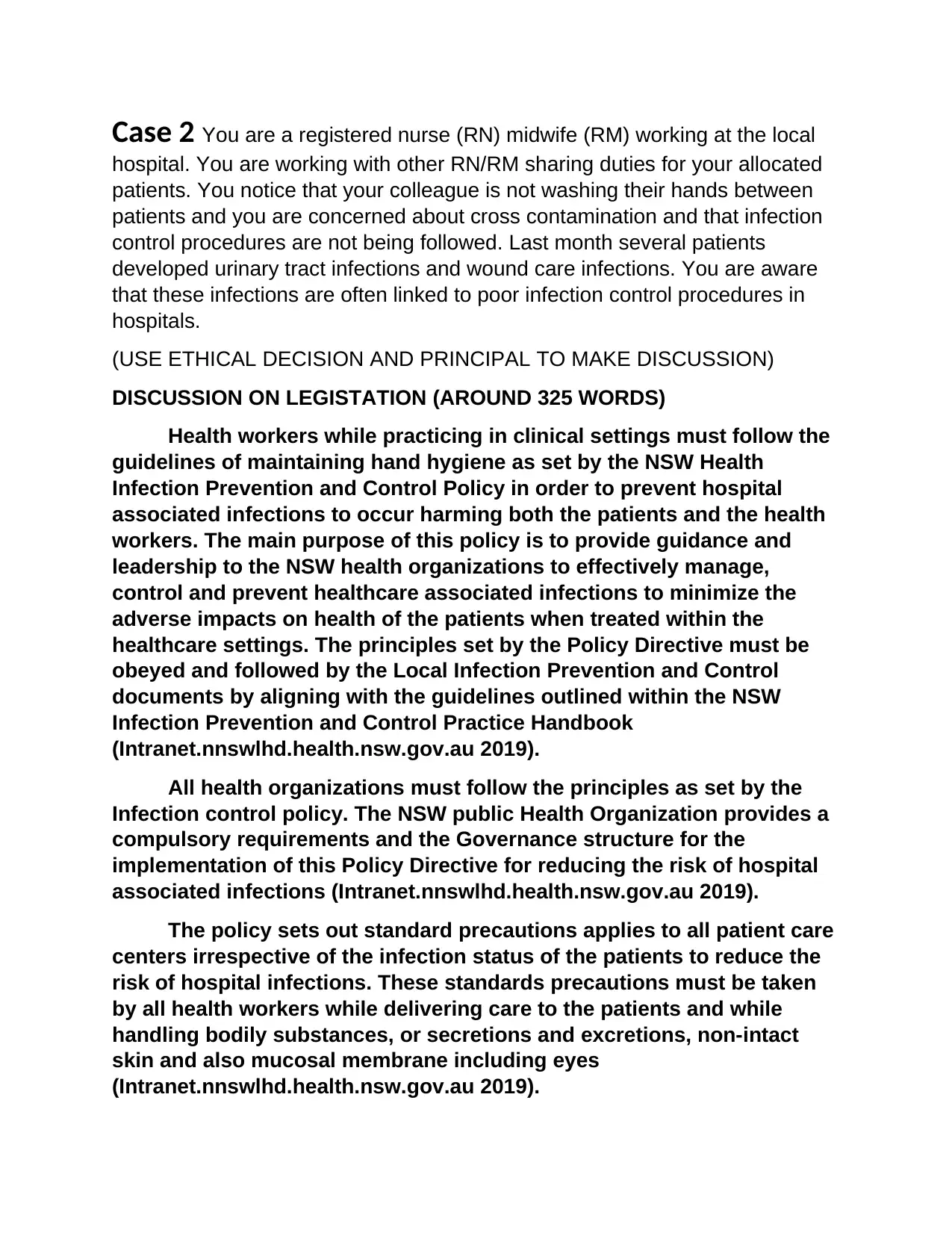
Case 2 You are a registered nurse (RN) midwife (RM) working at the local
hospital. You are working with other RN/RM sharing duties for your allocated
patients. You notice that your colleague is not washing their hands between
patients and you are concerned about cross contamination and that infection
control procedures are not being followed. Last month several patients
developed urinary tract infections and wound care infections. You are aware
that these infections are often linked to poor infection control procedures in
hospitals.
(USE ETHICAL DECISION AND PRINCIPAL TO MAKE DISCUSSION)
DISCUSSION ON LEGISTATION (AROUND 325 WORDS)
Health workers while practicing in clinical settings must follow the
guidelines of maintaining hand hygiene as set by the NSW Health
Infection Prevention and Control Policy in order to prevent hospital
associated infections to occur harming both the patients and the health
workers. The main purpose of this policy is to provide guidance and
leadership to the NSW health organizations to effectively manage,
control and prevent healthcare associated infections to minimize the
adverse impacts on health of the patients when treated within the
healthcare settings. The principles set by the Policy Directive must be
obeyed and followed by the Local Infection Prevention and Control
documents by aligning with the guidelines outlined within the NSW
Infection Prevention and Control Practice Handbook
(Intranet.nnswlhd.health.nsw.gov.au 2019).
All health organizations must follow the principles as set by the
Infection control policy. The NSW public Health Organization provides a
compulsory requirements and the Governance structure for the
implementation of this Policy Directive for reducing the risk of hospital
associated infections (Intranet.nnswlhd.health.nsw.gov.au 2019).
The policy sets out standard precautions applies to all patient care
centers irrespective of the infection status of the patients to reduce the
risk of hospital infections. These standards precautions must be taken
by all health workers while delivering care to the patients and while
handling bodily substances, or secretions and excretions, non-intact
skin and also mucosal membrane including eyes
(Intranet.nnswlhd.health.nsw.gov.au 2019).
hospital. You are working with other RN/RM sharing duties for your allocated
patients. You notice that your colleague is not washing their hands between
patients and you are concerned about cross contamination and that infection
control procedures are not being followed. Last month several patients
developed urinary tract infections and wound care infections. You are aware
that these infections are often linked to poor infection control procedures in
hospitals.
(USE ETHICAL DECISION AND PRINCIPAL TO MAKE DISCUSSION)
DISCUSSION ON LEGISTATION (AROUND 325 WORDS)
Health workers while practicing in clinical settings must follow the
guidelines of maintaining hand hygiene as set by the NSW Health
Infection Prevention and Control Policy in order to prevent hospital
associated infections to occur harming both the patients and the health
workers. The main purpose of this policy is to provide guidance and
leadership to the NSW health organizations to effectively manage,
control and prevent healthcare associated infections to minimize the
adverse impacts on health of the patients when treated within the
healthcare settings. The principles set by the Policy Directive must be
obeyed and followed by the Local Infection Prevention and Control
documents by aligning with the guidelines outlined within the NSW
Infection Prevention and Control Practice Handbook
(Intranet.nnswlhd.health.nsw.gov.au 2019).
All health organizations must follow the principles as set by the
Infection control policy. The NSW public Health Organization provides a
compulsory requirements and the Governance structure for the
implementation of this Policy Directive for reducing the risk of hospital
associated infections (Intranet.nnswlhd.health.nsw.gov.au 2019).
The policy sets out standard precautions applies to all patient care
centers irrespective of the infection status of the patients to reduce the
risk of hospital infections. These standards precautions must be taken
by all health workers while delivering care to the patients and while
handling bodily substances, or secretions and excretions, non-intact
skin and also mucosal membrane including eyes
(Intranet.nnswlhd.health.nsw.gov.au 2019).
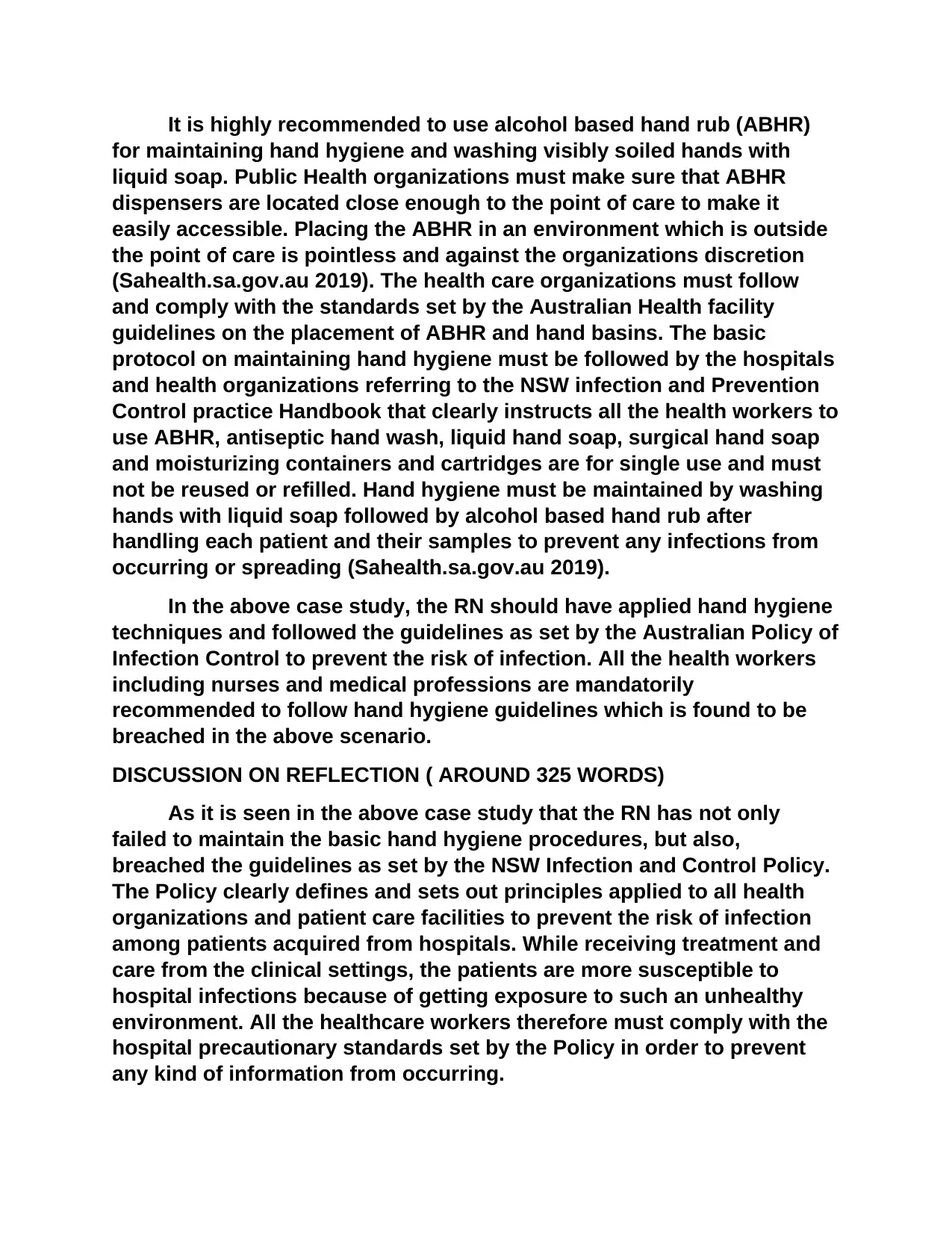
It is highly recommended to use alcohol based hand rub (ABHR)
for maintaining hand hygiene and washing visibly soiled hands with
liquid soap. Public Health organizations must make sure that ABHR
dispensers are located close enough to the point of care to make it
easily accessible. Placing the ABHR in an environment which is outside
the point of care is pointless and against the organizations discretion
(Sahealth.sa.gov.au 2019). The health care organizations must follow
and comply with the standards set by the Australian Health facility
guidelines on the placement of ABHR and hand basins. The basic
protocol on maintaining hand hygiene must be followed by the hospitals
and health organizations referring to the NSW infection and Prevention
Control practice Handbook that clearly instructs all the health workers to
use ABHR, antiseptic hand wash, liquid hand soap, surgical hand soap
and moisturizing containers and cartridges are for single use and must
not be reused or refilled. Hand hygiene must be maintained by washing
hands with liquid soap followed by alcohol based hand rub after
handling each patient and their samples to prevent any infections from
occurring or spreading (Sahealth.sa.gov.au 2019).
In the above case study, the RN should have applied hand hygiene
techniques and followed the guidelines as set by the Australian Policy of
Infection Control to prevent the risk of infection. All the health workers
including nurses and medical professions are mandatorily
recommended to follow hand hygiene guidelines which is found to be
breached in the above scenario.
DISCUSSION ON REFLECTION ( AROUND 325 WORDS)
As it is seen in the above case study that the RN has not only
failed to maintain the basic hand hygiene procedures, but also,
breached the guidelines as set by the NSW Infection and Control Policy.
The Policy clearly defines and sets out principles applied to all health
organizations and patient care facilities to prevent the risk of infection
among patients acquired from hospitals. While receiving treatment and
care from the clinical settings, the patients are more susceptible to
hospital infections because of getting exposure to such an unhealthy
environment. All the healthcare workers therefore must comply with the
hospital precautionary standards set by the Policy in order to prevent
any kind of information from occurring.
for maintaining hand hygiene and washing visibly soiled hands with
liquid soap. Public Health organizations must make sure that ABHR
dispensers are located close enough to the point of care to make it
easily accessible. Placing the ABHR in an environment which is outside
the point of care is pointless and against the organizations discretion
(Sahealth.sa.gov.au 2019). The health care organizations must follow
and comply with the standards set by the Australian Health facility
guidelines on the placement of ABHR and hand basins. The basic
protocol on maintaining hand hygiene must be followed by the hospitals
and health organizations referring to the NSW infection and Prevention
Control practice Handbook that clearly instructs all the health workers to
use ABHR, antiseptic hand wash, liquid hand soap, surgical hand soap
and moisturizing containers and cartridges are for single use and must
not be reused or refilled. Hand hygiene must be maintained by washing
hands with liquid soap followed by alcohol based hand rub after
handling each patient and their samples to prevent any infections from
occurring or spreading (Sahealth.sa.gov.au 2019).
In the above case study, the RN should have applied hand hygiene
techniques and followed the guidelines as set by the Australian Policy of
Infection Control to prevent the risk of infection. All the health workers
including nurses and medical professions are mandatorily
recommended to follow hand hygiene guidelines which is found to be
breached in the above scenario.
DISCUSSION ON REFLECTION ( AROUND 325 WORDS)
As it is seen in the above case study that the RN has not only
failed to maintain the basic hand hygiene procedures, but also,
breached the guidelines as set by the NSW Infection and Control Policy.
The Policy clearly defines and sets out principles applied to all health
organizations and patient care facilities to prevent the risk of infection
among patients acquired from hospitals. While receiving treatment and
care from the clinical settings, the patients are more susceptible to
hospital infections because of getting exposure to such an unhealthy
environment. All the healthcare workers therefore must comply with the
hospital precautionary standards set by the Policy in order to prevent
any kind of information from occurring.
⊘ This is a preview!⊘
Do you want full access?
Subscribe today to unlock all pages.

Trusted by 1+ million students worldwide
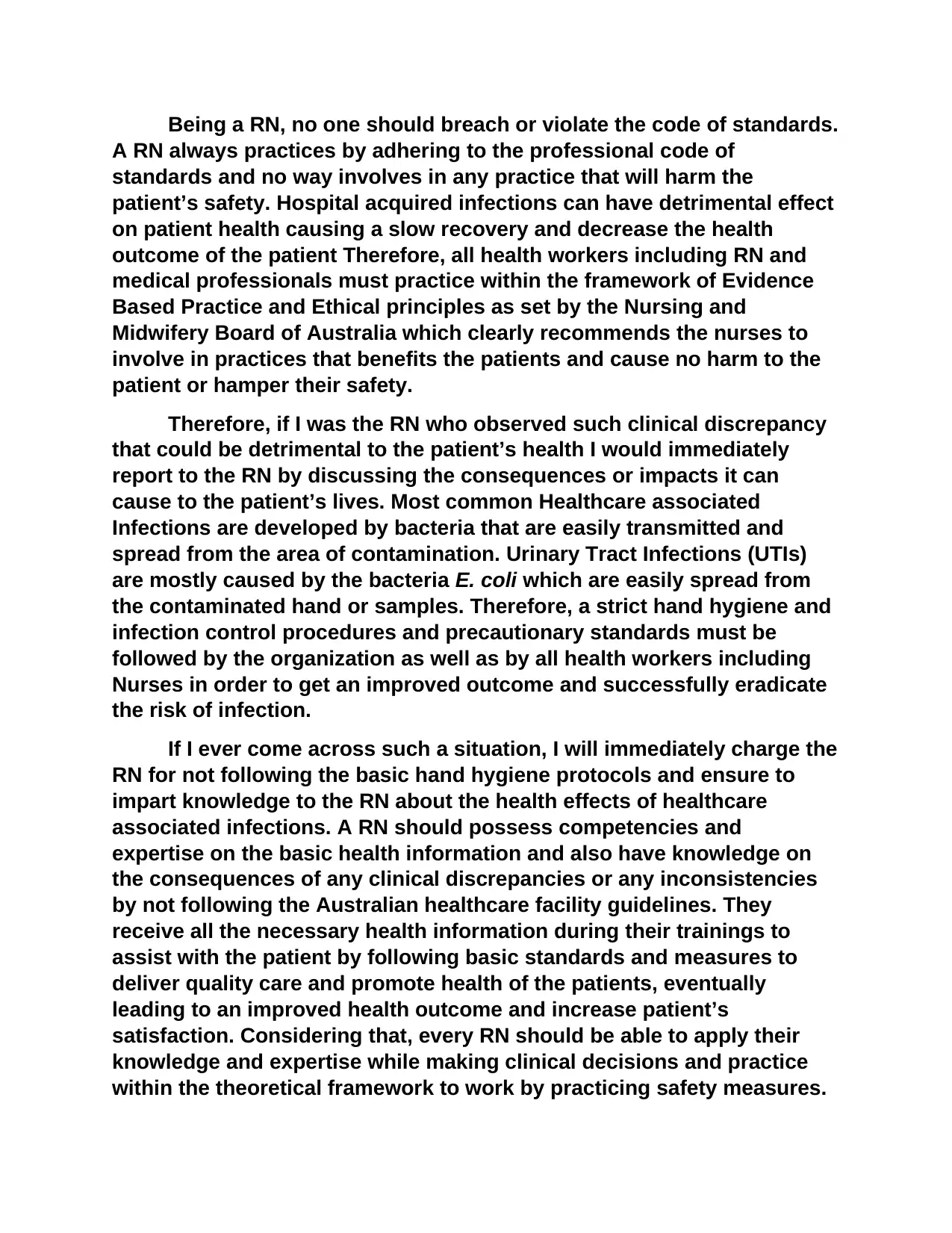
Being a RN, no one should breach or violate the code of standards.
A RN always practices by adhering to the professional code of
standards and no way involves in any practice that will harm the
patient’s safety. Hospital acquired infections can have detrimental effect
on patient health causing a slow recovery and decrease the health
outcome of the patient Therefore, all health workers including RN and
medical professionals must practice within the framework of Evidence
Based Practice and Ethical principles as set by the Nursing and
Midwifery Board of Australia which clearly recommends the nurses to
involve in practices that benefits the patients and cause no harm to the
patient or hamper their safety.
Therefore, if I was the RN who observed such clinical discrepancy
that could be detrimental to the patient’s health I would immediately
report to the RN by discussing the consequences or impacts it can
cause to the patient’s lives. Most common Healthcare associated
Infections are developed by bacteria that are easily transmitted and
spread from the area of contamination. Urinary Tract Infections (UTIs)
are mostly caused by the bacteria E. coli which are easily spread from
the contaminated hand or samples. Therefore, a strict hand hygiene and
infection control procedures and precautionary standards must be
followed by the organization as well as by all health workers including
Nurses in order to get an improved outcome and successfully eradicate
the risk of infection.
If I ever come across such a situation, I will immediately charge the
RN for not following the basic hand hygiene protocols and ensure to
impart knowledge to the RN about the health effects of healthcare
associated infections. A RN should possess competencies and
expertise on the basic health information and also have knowledge on
the consequences of any clinical discrepancies or any inconsistencies
by not following the Australian healthcare facility guidelines. They
receive all the necessary health information during their trainings to
assist with the patient by following basic standards and measures to
deliver quality care and promote health of the patients, eventually
leading to an improved health outcome and increase patient’s
satisfaction. Considering that, every RN should be able to apply their
knowledge and expertise while making clinical decisions and practice
within the theoretical framework to work by practicing safety measures.
A RN always practices by adhering to the professional code of
standards and no way involves in any practice that will harm the
patient’s safety. Hospital acquired infections can have detrimental effect
on patient health causing a slow recovery and decrease the health
outcome of the patient Therefore, all health workers including RN and
medical professionals must practice within the framework of Evidence
Based Practice and Ethical principles as set by the Nursing and
Midwifery Board of Australia which clearly recommends the nurses to
involve in practices that benefits the patients and cause no harm to the
patient or hamper their safety.
Therefore, if I was the RN who observed such clinical discrepancy
that could be detrimental to the patient’s health I would immediately
report to the RN by discussing the consequences or impacts it can
cause to the patient’s lives. Most common Healthcare associated
Infections are developed by bacteria that are easily transmitted and
spread from the area of contamination. Urinary Tract Infections (UTIs)
are mostly caused by the bacteria E. coli which are easily spread from
the contaminated hand or samples. Therefore, a strict hand hygiene and
infection control procedures and precautionary standards must be
followed by the organization as well as by all health workers including
Nurses in order to get an improved outcome and successfully eradicate
the risk of infection.
If I ever come across such a situation, I will immediately charge the
RN for not following the basic hand hygiene protocols and ensure to
impart knowledge to the RN about the health effects of healthcare
associated infections. A RN should possess competencies and
expertise on the basic health information and also have knowledge on
the consequences of any clinical discrepancies or any inconsistencies
by not following the Australian healthcare facility guidelines. They
receive all the necessary health information during their trainings to
assist with the patient by following basic standards and measures to
deliver quality care and promote health of the patients, eventually
leading to an improved health outcome and increase patient’s
satisfaction. Considering that, every RN should be able to apply their
knowledge and expertise while making clinical decisions and practice
within the theoretical framework to work by practicing safety measures.
Paraphrase This Document
Need a fresh take? Get an instant paraphrase of this document with our AI Paraphraser
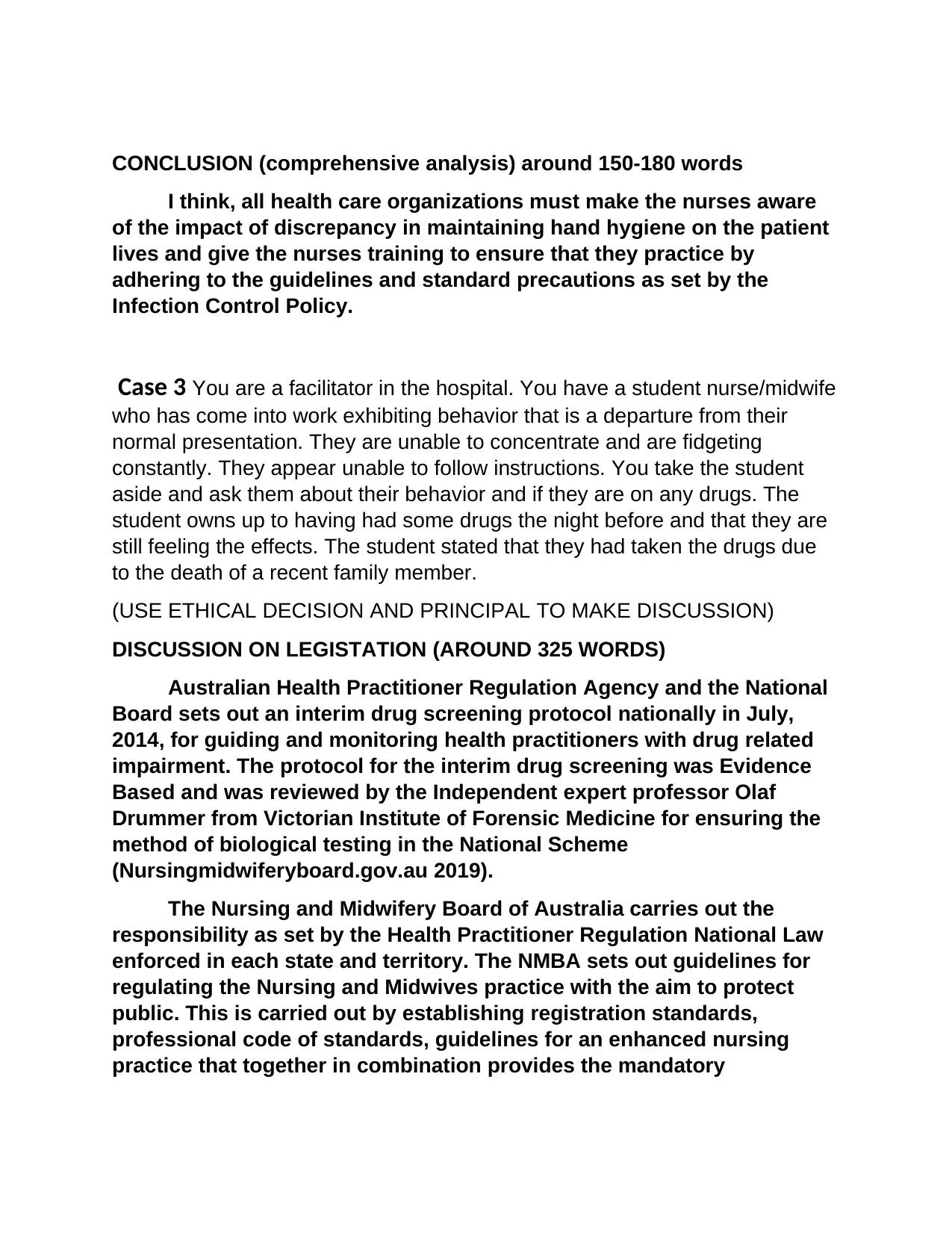
CONCLUSION (comprehensive analysis) around 150-180 words
I think, all health care organizations must make the nurses aware
of the impact of discrepancy in maintaining hand hygiene on the patient
lives and give the nurses training to ensure that they practice by
adhering to the guidelines and standard precautions as set by the
Infection Control Policy.
Case 3 You are a facilitator in the hospital. You have a student nurse/midwife
who has come into work exhibiting behavior that is a departure from their
normal presentation. They are unable to concentrate and are fidgeting
constantly. They appear unable to follow instructions. You take the student
aside and ask them about their behavior and if they are on any drugs. The
student owns up to having had some drugs the night before and that they are
still feeling the effects. The student stated that they had taken the drugs due
to the death of a recent family member.
(USE ETHICAL DECISION AND PRINCIPAL TO MAKE DISCUSSION)
DISCUSSION ON LEGISTATION (AROUND 325 WORDS)
Australian Health Practitioner Regulation Agency and the National
Board sets out an interim drug screening protocol nationally in July,
2014, for guiding and monitoring health practitioners with drug related
impairment. The protocol for the interim drug screening was Evidence
Based and was reviewed by the Independent expert professor Olaf
Drummer from Victorian Institute of Forensic Medicine for ensuring the
method of biological testing in the National Scheme
(Nursingmidwiferyboard.gov.au 2019).
The Nursing and Midwifery Board of Australia carries out the
responsibility as set by the Health Practitioner Regulation National Law
enforced in each state and territory. The NMBA sets out guidelines for
regulating the Nursing and Midwives practice with the aim to protect
public. This is carried out by establishing registration standards,
professional code of standards, guidelines for an enhanced nursing
practice that together in combination provides the mandatory
I think, all health care organizations must make the nurses aware
of the impact of discrepancy in maintaining hand hygiene on the patient
lives and give the nurses training to ensure that they practice by
adhering to the guidelines and standard precautions as set by the
Infection Control Policy.
Case 3 You are a facilitator in the hospital. You have a student nurse/midwife
who has come into work exhibiting behavior that is a departure from their
normal presentation. They are unable to concentrate and are fidgeting
constantly. They appear unable to follow instructions. You take the student
aside and ask them about their behavior and if they are on any drugs. The
student owns up to having had some drugs the night before and that they are
still feeling the effects. The student stated that they had taken the drugs due
to the death of a recent family member.
(USE ETHICAL DECISION AND PRINCIPAL TO MAKE DISCUSSION)
DISCUSSION ON LEGISTATION (AROUND 325 WORDS)
Australian Health Practitioner Regulation Agency and the National
Board sets out an interim drug screening protocol nationally in July,
2014, for guiding and monitoring health practitioners with drug related
impairment. The protocol for the interim drug screening was Evidence
Based and was reviewed by the Independent expert professor Olaf
Drummer from Victorian Institute of Forensic Medicine for ensuring the
method of biological testing in the National Scheme
(Nursingmidwiferyboard.gov.au 2019).
The Nursing and Midwifery Board of Australia carries out the
responsibility as set by the Health Practitioner Regulation National Law
enforced in each state and territory. The NMBA sets out guidelines for
regulating the Nursing and Midwives practice with the aim to protect
public. This is carried out by establishing registration standards,
professional code of standards, guidelines for an enhanced nursing
practice that together in combination provides the mandatory
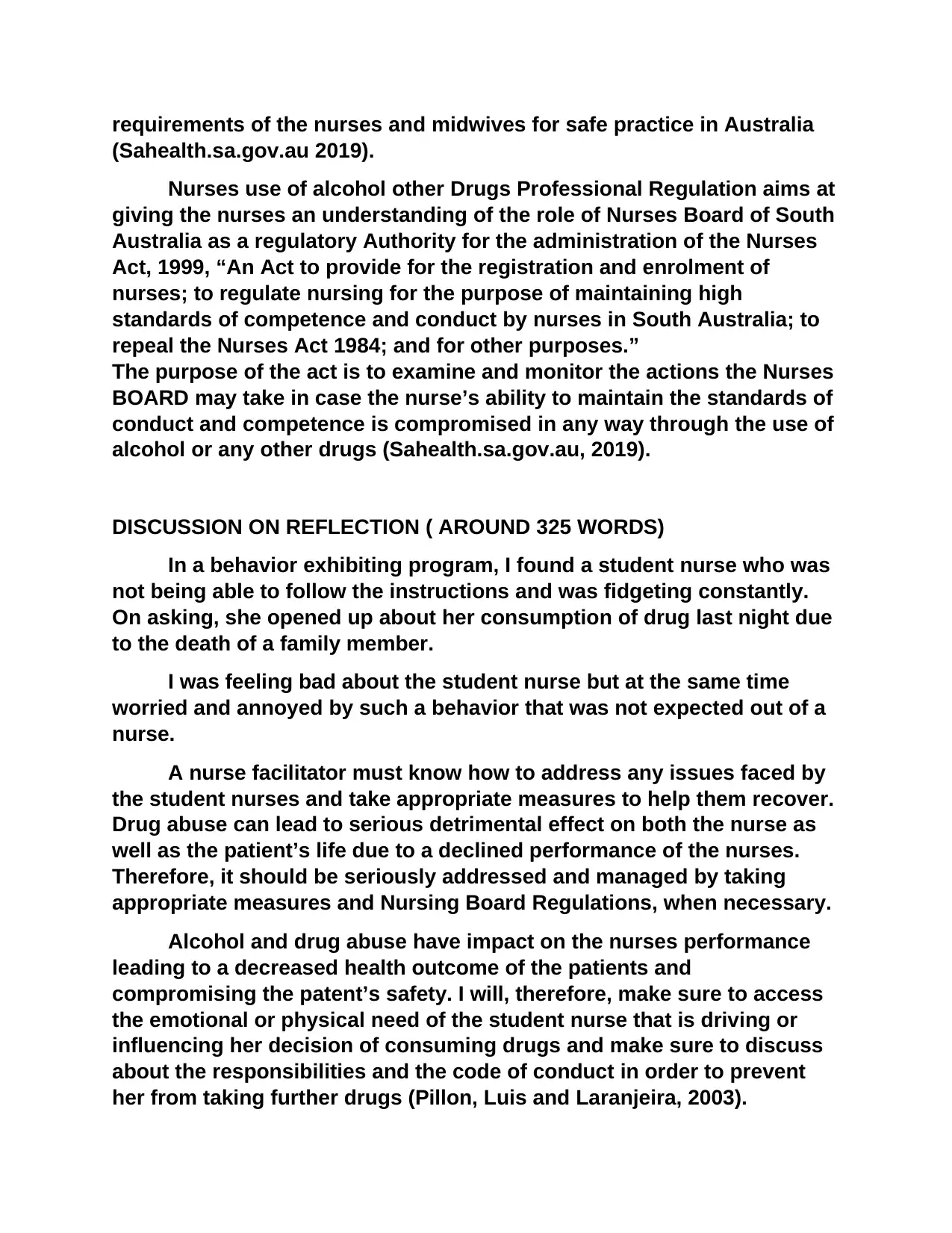
requirements of the nurses and midwives for safe practice in Australia
(Sahealth.sa.gov.au 2019).
Nurses use of alcohol other Drugs Professional Regulation aims at
giving the nurses an understanding of the role of Nurses Board of South
Australia as a regulatory Authority for the administration of the Nurses
Act, 1999, “An Act to provide for the registration and enrolment of
nurses; to regulate nursing for the purpose of maintaining high
standards of competence and conduct by nurses in South Australia; to
repeal the Nurses Act 1984; and for other purposes.”
The purpose of the act is to examine and monitor the actions the Nurses
BOARD may take in case the nurse’s ability to maintain the standards of
conduct and competence is compromised in any way through the use of
alcohol or any other drugs (Sahealth.sa.gov.au, 2019).
DISCUSSION ON REFLECTION ( AROUND 325 WORDS)
In a behavior exhibiting program, I found a student nurse who was
not being able to follow the instructions and was fidgeting constantly.
On asking, she opened up about her consumption of drug last night due
to the death of a family member.
I was feeling bad about the student nurse but at the same time
worried and annoyed by such a behavior that was not expected out of a
nurse.
A nurse facilitator must know how to address any issues faced by
the student nurses and take appropriate measures to help them recover.
Drug abuse can lead to serious detrimental effect on both the nurse as
well as the patient’s life due to a declined performance of the nurses.
Therefore, it should be seriously addressed and managed by taking
appropriate measures and Nursing Board Regulations, when necessary.
Alcohol and drug abuse have impact on the nurses performance
leading to a decreased health outcome of the patients and
compromising the patent’s safety. I will, therefore, make sure to access
the emotional or physical need of the student nurse that is driving or
influencing her decision of consuming drugs and make sure to discuss
about the responsibilities and the code of conduct in order to prevent
her from taking further drugs (Pillon, Luis and Laranjeira, 2003).
(Sahealth.sa.gov.au 2019).
Nurses use of alcohol other Drugs Professional Regulation aims at
giving the nurses an understanding of the role of Nurses Board of South
Australia as a regulatory Authority for the administration of the Nurses
Act, 1999, “An Act to provide for the registration and enrolment of
nurses; to regulate nursing for the purpose of maintaining high
standards of competence and conduct by nurses in South Australia; to
repeal the Nurses Act 1984; and for other purposes.”
The purpose of the act is to examine and monitor the actions the Nurses
BOARD may take in case the nurse’s ability to maintain the standards of
conduct and competence is compromised in any way through the use of
alcohol or any other drugs (Sahealth.sa.gov.au, 2019).
DISCUSSION ON REFLECTION ( AROUND 325 WORDS)
In a behavior exhibiting program, I found a student nurse who was
not being able to follow the instructions and was fidgeting constantly.
On asking, she opened up about her consumption of drug last night due
to the death of a family member.
I was feeling bad about the student nurse but at the same time
worried and annoyed by such a behavior that was not expected out of a
nurse.
A nurse facilitator must know how to address any issues faced by
the student nurses and take appropriate measures to help them recover.
Drug abuse can lead to serious detrimental effect on both the nurse as
well as the patient’s life due to a declined performance of the nurses.
Therefore, it should be seriously addressed and managed by taking
appropriate measures and Nursing Board Regulations, when necessary.
Alcohol and drug abuse have impact on the nurses performance
leading to a decreased health outcome of the patients and
compromising the patent’s safety. I will, therefore, make sure to access
the emotional or physical need of the student nurse that is driving or
influencing her decision of consuming drugs and make sure to discuss
about the responsibilities and the code of conduct in order to prevent
her from taking further drugs (Pillon, Luis and Laranjeira, 2003).
⊘ This is a preview!⊘
Do you want full access?
Subscribe today to unlock all pages.

Trusted by 1+ million students worldwide
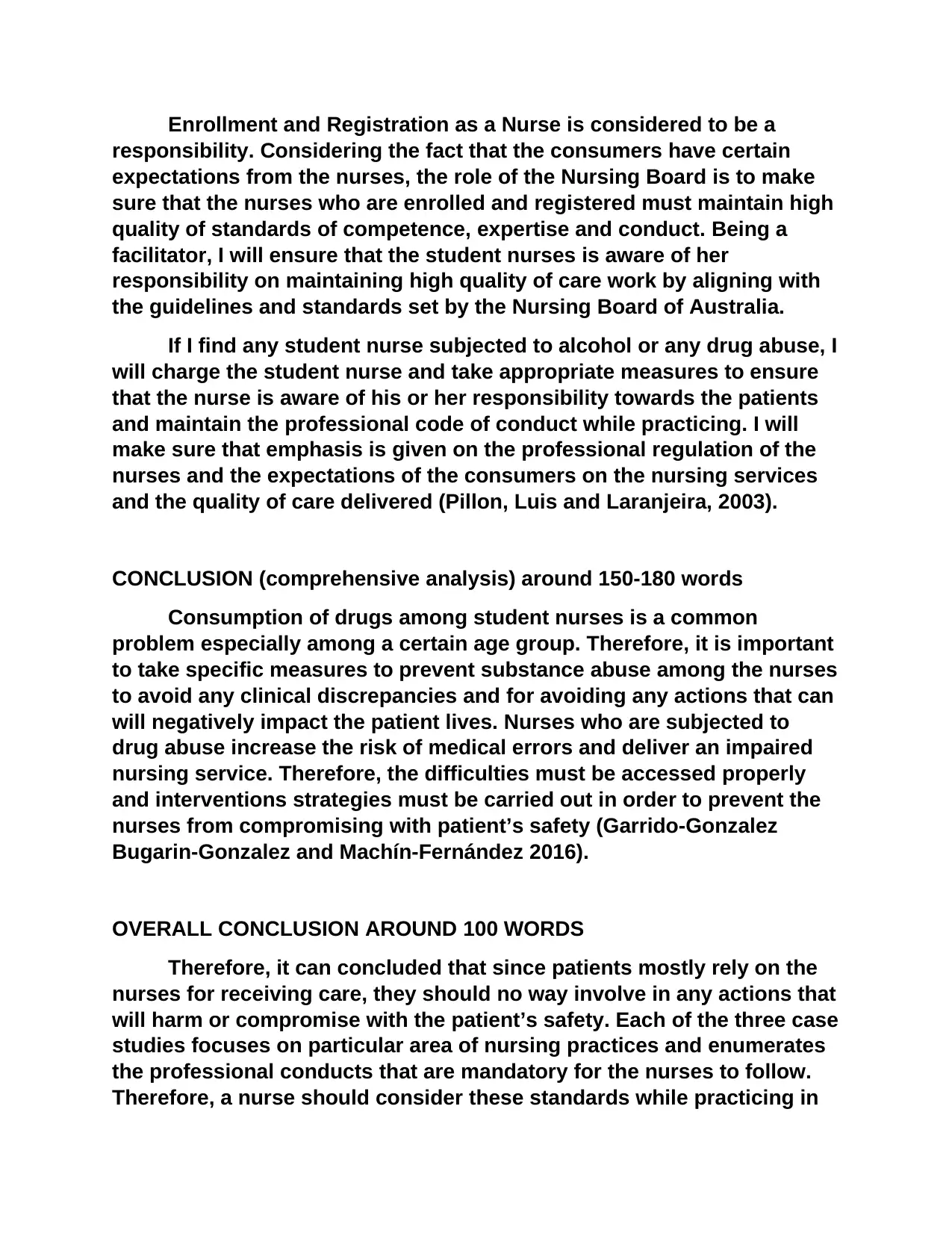
Enrollment and Registration as a Nurse is considered to be a
responsibility. Considering the fact that the consumers have certain
expectations from the nurses, the role of the Nursing Board is to make
sure that the nurses who are enrolled and registered must maintain high
quality of standards of competence, expertise and conduct. Being a
facilitator, I will ensure that the student nurses is aware of her
responsibility on maintaining high quality of care work by aligning with
the guidelines and standards set by the Nursing Board of Australia.
If I find any student nurse subjected to alcohol or any drug abuse, I
will charge the student nurse and take appropriate measures to ensure
that the nurse is aware of his or her responsibility towards the patients
and maintain the professional code of conduct while practicing. I will
make sure that emphasis is given on the professional regulation of the
nurses and the expectations of the consumers on the nursing services
and the quality of care delivered (Pillon, Luis and Laranjeira, 2003).
CONCLUSION (comprehensive analysis) around 150-180 words
Consumption of drugs among student nurses is a common
problem especially among a certain age group. Therefore, it is important
to take specific measures to prevent substance abuse among the nurses
to avoid any clinical discrepancies and for avoiding any actions that can
will negatively impact the patient lives. Nurses who are subjected to
drug abuse increase the risk of medical errors and deliver an impaired
nursing service. Therefore, the difficulties must be accessed properly
and interventions strategies must be carried out in order to prevent the
nurses from compromising with patient’s safety (Garrido-Gonzalez
Bugarin-Gonzalez and Machín-Fernández 2016).
OVERALL CONCLUSION AROUND 100 WORDS
Therefore, it can concluded that since patients mostly rely on the
nurses for receiving care, they should no way involve in any actions that
will harm or compromise with the patient’s safety. Each of the three case
studies focuses on particular area of nursing practices and enumerates
the professional conducts that are mandatory for the nurses to follow.
Therefore, a nurse should consider these standards while practicing in
responsibility. Considering the fact that the consumers have certain
expectations from the nurses, the role of the Nursing Board is to make
sure that the nurses who are enrolled and registered must maintain high
quality of standards of competence, expertise and conduct. Being a
facilitator, I will ensure that the student nurses is aware of her
responsibility on maintaining high quality of care work by aligning with
the guidelines and standards set by the Nursing Board of Australia.
If I find any student nurse subjected to alcohol or any drug abuse, I
will charge the student nurse and take appropriate measures to ensure
that the nurse is aware of his or her responsibility towards the patients
and maintain the professional code of conduct while practicing. I will
make sure that emphasis is given on the professional regulation of the
nurses and the expectations of the consumers on the nursing services
and the quality of care delivered (Pillon, Luis and Laranjeira, 2003).
CONCLUSION (comprehensive analysis) around 150-180 words
Consumption of drugs among student nurses is a common
problem especially among a certain age group. Therefore, it is important
to take specific measures to prevent substance abuse among the nurses
to avoid any clinical discrepancies and for avoiding any actions that can
will negatively impact the patient lives. Nurses who are subjected to
drug abuse increase the risk of medical errors and deliver an impaired
nursing service. Therefore, the difficulties must be accessed properly
and interventions strategies must be carried out in order to prevent the
nurses from compromising with patient’s safety (Garrido-Gonzalez
Bugarin-Gonzalez and Machín-Fernández 2016).
OVERALL CONCLUSION AROUND 100 WORDS
Therefore, it can concluded that since patients mostly rely on the
nurses for receiving care, they should no way involve in any actions that
will harm or compromise with the patient’s safety. Each of the three case
studies focuses on particular area of nursing practices and enumerates
the professional conducts that are mandatory for the nurses to follow.
Therefore, a nurse should consider these standards while practicing in
Paraphrase This Document
Need a fresh take? Get an instant paraphrase of this document with our AI Paraphraser
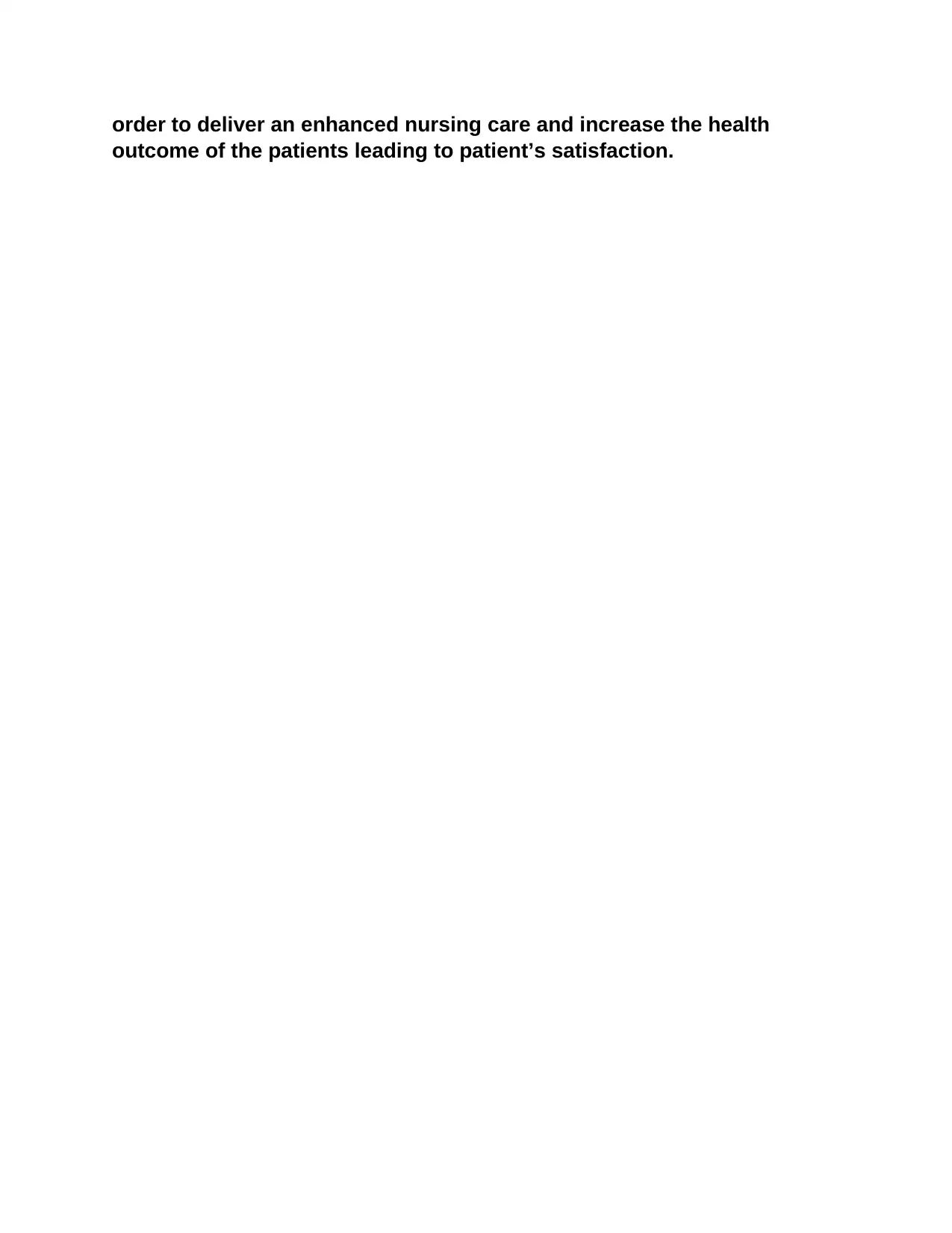
order to deliver an enhanced nursing care and increase the health
outcome of the patients leading to patient’s satisfaction.
outcome of the patients leading to patient’s satisfaction.
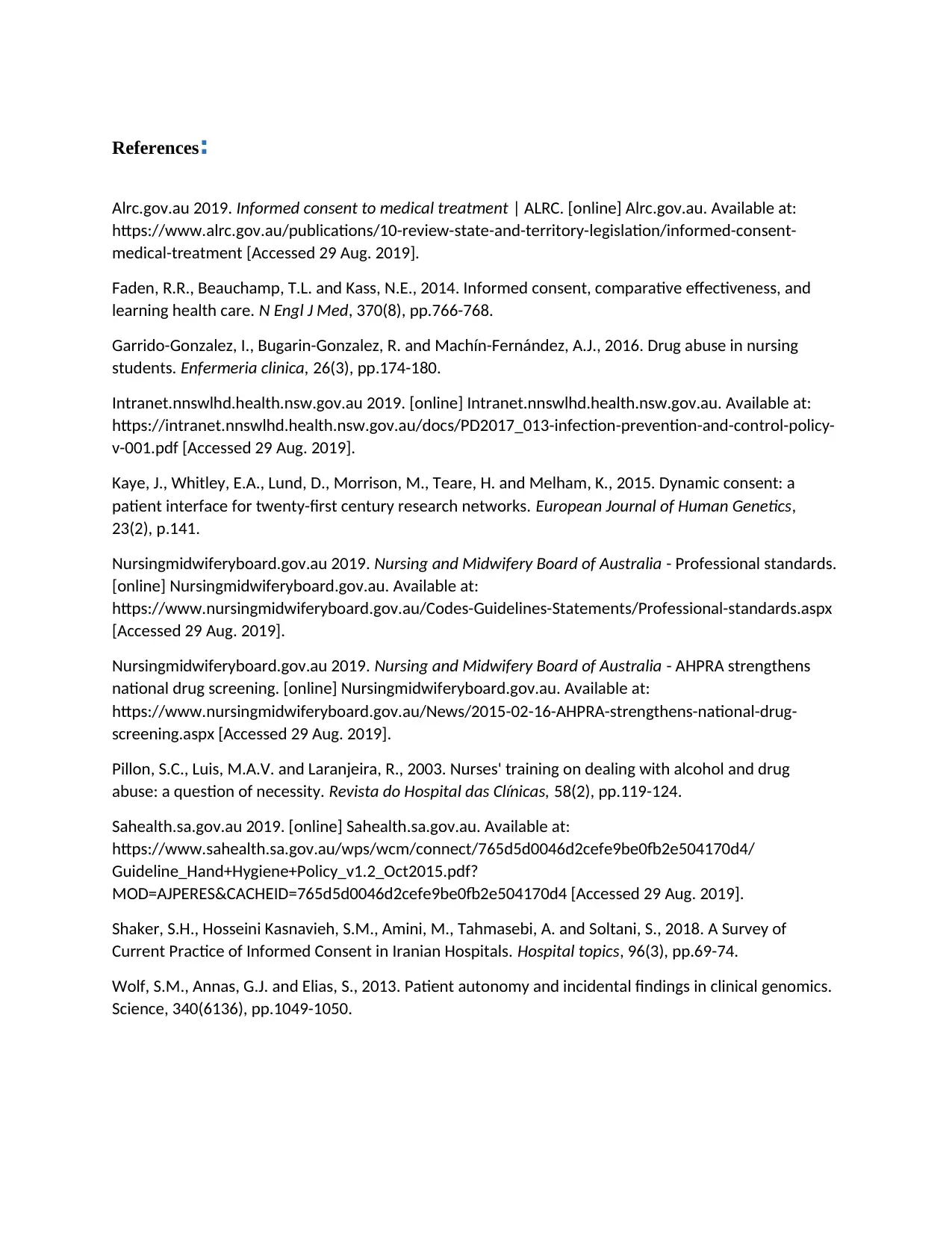
References:
Alrc.gov.au 2019. Informed consent to medical treatment | ALRC. [online] Alrc.gov.au. Available at:
https://www.alrc.gov.au/publications/10-review-state-and-territory-legislation/informed-consent-
medical-treatment [Accessed 29 Aug. 2019].
Faden, R.R., Beauchamp, T.L. and Kass, N.E., 2014. Informed consent, comparative effectiveness, and
learning health care. N Engl J Med, 370(8), pp.766-768.
Garrido-Gonzalez, I., Bugarin-Gonzalez, R. and Machín-Fernández, A.J., 2016. Drug abuse in nursing
students. Enfermeria clinica, 26(3), pp.174-180.
Intranet.nnswlhd.health.nsw.gov.au 2019. [online] Intranet.nnswlhd.health.nsw.gov.au. Available at:
https://intranet.nnswlhd.health.nsw.gov.au/docs/PD2017_013-infection-prevention-and-control-policy-
v-001.pdf [Accessed 29 Aug. 2019].
Kaye, J., Whitley, E.A., Lund, D., Morrison, M., Teare, H. and Melham, K., 2015. Dynamic consent: a
patient interface for twenty-first century research networks. European Journal of Human Genetics,
23(2), p.141.
Nursingmidwiferyboard.gov.au 2019. Nursing and Midwifery Board of Australia - Professional standards.
[online] Nursingmidwiferyboard.gov.au. Available at:
https://www.nursingmidwiferyboard.gov.au/Codes-Guidelines-Statements/Professional-standards.aspx
[Accessed 29 Aug. 2019].
Nursingmidwiferyboard.gov.au 2019. Nursing and Midwifery Board of Australia - AHPRA strengthens
national drug screening. [online] Nursingmidwiferyboard.gov.au. Available at:
https://www.nursingmidwiferyboard.gov.au/News/2015-02-16-AHPRA-strengthens-national-drug-
screening.aspx [Accessed 29 Aug. 2019].
Pillon, S.C., Luis, M.A.V. and Laranjeira, R., 2003. Nurses' training on dealing with alcohol and drug
abuse: a question of necessity. Revista do Hospital das Clínicas, 58(2), pp.119-124.
Sahealth.sa.gov.au 2019. [online] Sahealth.sa.gov.au. Available at:
https://www.sahealth.sa.gov.au/wps/wcm/connect/765d5d0046d2cefe9be0fb2e504170d4/
Guideline_Hand+Hygiene+Policy_v1.2_Oct2015.pdf?
MOD=AJPERES&CACHEID=765d5d0046d2cefe9be0fb2e504170d4 [Accessed 29 Aug. 2019].
Shaker, S.H., Hosseini Kasnavieh, S.M., Amini, M., Tahmasebi, A. and Soltani, S., 2018. A Survey of
Current Practice of Informed Consent in Iranian Hospitals. Hospital topics, 96(3), pp.69-74.
Wolf, S.M., Annas, G.J. and Elias, S., 2013. Patient autonomy and incidental findings in clinical genomics.
Science, 340(6136), pp.1049-1050.
Alrc.gov.au 2019. Informed consent to medical treatment | ALRC. [online] Alrc.gov.au. Available at:
https://www.alrc.gov.au/publications/10-review-state-and-territory-legislation/informed-consent-
medical-treatment [Accessed 29 Aug. 2019].
Faden, R.R., Beauchamp, T.L. and Kass, N.E., 2014. Informed consent, comparative effectiveness, and
learning health care. N Engl J Med, 370(8), pp.766-768.
Garrido-Gonzalez, I., Bugarin-Gonzalez, R. and Machín-Fernández, A.J., 2016. Drug abuse in nursing
students. Enfermeria clinica, 26(3), pp.174-180.
Intranet.nnswlhd.health.nsw.gov.au 2019. [online] Intranet.nnswlhd.health.nsw.gov.au. Available at:
https://intranet.nnswlhd.health.nsw.gov.au/docs/PD2017_013-infection-prevention-and-control-policy-
v-001.pdf [Accessed 29 Aug. 2019].
Kaye, J., Whitley, E.A., Lund, D., Morrison, M., Teare, H. and Melham, K., 2015. Dynamic consent: a
patient interface for twenty-first century research networks. European Journal of Human Genetics,
23(2), p.141.
Nursingmidwiferyboard.gov.au 2019. Nursing and Midwifery Board of Australia - Professional standards.
[online] Nursingmidwiferyboard.gov.au. Available at:
https://www.nursingmidwiferyboard.gov.au/Codes-Guidelines-Statements/Professional-standards.aspx
[Accessed 29 Aug. 2019].
Nursingmidwiferyboard.gov.au 2019. Nursing and Midwifery Board of Australia - AHPRA strengthens
national drug screening. [online] Nursingmidwiferyboard.gov.au. Available at:
https://www.nursingmidwiferyboard.gov.au/News/2015-02-16-AHPRA-strengthens-national-drug-
screening.aspx [Accessed 29 Aug. 2019].
Pillon, S.C., Luis, M.A.V. and Laranjeira, R., 2003. Nurses' training on dealing with alcohol and drug
abuse: a question of necessity. Revista do Hospital das Clínicas, 58(2), pp.119-124.
Sahealth.sa.gov.au 2019. [online] Sahealth.sa.gov.au. Available at:
https://www.sahealth.sa.gov.au/wps/wcm/connect/765d5d0046d2cefe9be0fb2e504170d4/
Guideline_Hand+Hygiene+Policy_v1.2_Oct2015.pdf?
MOD=AJPERES&CACHEID=765d5d0046d2cefe9be0fb2e504170d4 [Accessed 29 Aug. 2019].
Shaker, S.H., Hosseini Kasnavieh, S.M., Amini, M., Tahmasebi, A. and Soltani, S., 2018. A Survey of
Current Practice of Informed Consent in Iranian Hospitals. Hospital topics, 96(3), pp.69-74.
Wolf, S.M., Annas, G.J. and Elias, S., 2013. Patient autonomy and incidental findings in clinical genomics.
Science, 340(6136), pp.1049-1050.
⊘ This is a preview!⊘
Do you want full access?
Subscribe today to unlock all pages.

Trusted by 1+ million students worldwide
1 out of 12
Related Documents
Your All-in-One AI-Powered Toolkit for Academic Success.
+13062052269
info@desklib.com
Available 24*7 on WhatsApp / Email
![[object Object]](/_next/static/media/star-bottom.7253800d.svg)
Unlock your academic potential
Copyright © 2020–2025 A2Z Services. All Rights Reserved. Developed and managed by ZUCOL.




